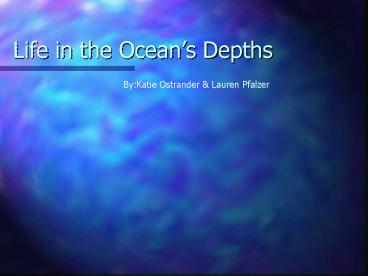Life in the Oceans Depths - PowerPoint PPT Presentation
1 / 10
Title:
Life in the Oceans Depths
Description:
Conditions of the deep ocean appear to make it the most inhospitable place ... of the molt cycle and may actually be involved in energy transfer during molting. ... – PowerPoint PPT presentation
Number of Views:66
Avg rating:3.0/5.0
Title: Life in the Oceans Depths
1
Life in the Oceans Depths
ByKatie Ostrander Lauren Pfalzer
2
Characteristics of the Deep Sea
- Conditions of the deep ocean appear to make it
the most inhospitable place for life. - There is a lack of light, frigid temperatures,
and an incredible amount of pressure. - The lack of light has had the greatest
evolutionary impact.
3
Life in the Dark
- Animals inhabiting the deep sea display
intriguing adaptations that allow them to survive
in a dark environment. - Red colors of deep sea crustaceans vary according
to the state of the molt cycle and may actually
be involved in energy transfer during molting.
4
Life in the Dark
- Even though sunlight cannot penetrate to the
depths of the ocean, many deep- sea animals
produce their own light in the form of
bioluminescence. - In deepwater animals, bioluminescence functions
in species identification, locating males,
locating prey, and defense.
5
Life in the Dark
- Fishes that live in the oceans depths have eyes
that are adapted for seeing in dim light. They
are tubular and contain two retinas. The shape of
the eye gives them better depth perception so
they are less likely to miss their prey when they
strike.
6
Life in the Dark
- In the depths of the sea, food is quite scarce.
There are no photosynthetic organisms to produce
food, but organic wastes, scraps of food, and
dead and dying organisms drift down slowly form
above. Some of the food is consumed before it
reaches the bottom. - Deep-sea fishes display a variety of adaptations
such as sharp teeth, large mouths, and huge
stomachs that help them survive in a habitat with
limited food.
7
Giants of the Deep
- MOST deep-sea animals are small compared to those
living in surface waters, BUT a few are giants
compared to their shallow-water relatives. - A possible reason is that they live longer, thus
giving them time to grow.
8
Living Fossils from the Deep
- The environmental conditions of the deep sea have
been relatively stable for more than 100 million
years, and, as a result, several organisms have
changed very little from when they first evolved.
9
Vent Communities
- Marine Scientists have discovered several vent
communities off the coast of Oregon, the west
coast of Florida, the Gulf Coast of Mexico, and
in the central Gulf of California. - Despite the extremes of the temperature and
pressure, these self-contained communities are
some of the most productive in the sea and
demonstrate that communities can exist without
solar energy.
10
Vent Communities
- Thriving marine communities that depend on
chemosynthetic bacteria for primary production
exist on the ocean floor around hydrothermal
vents.































